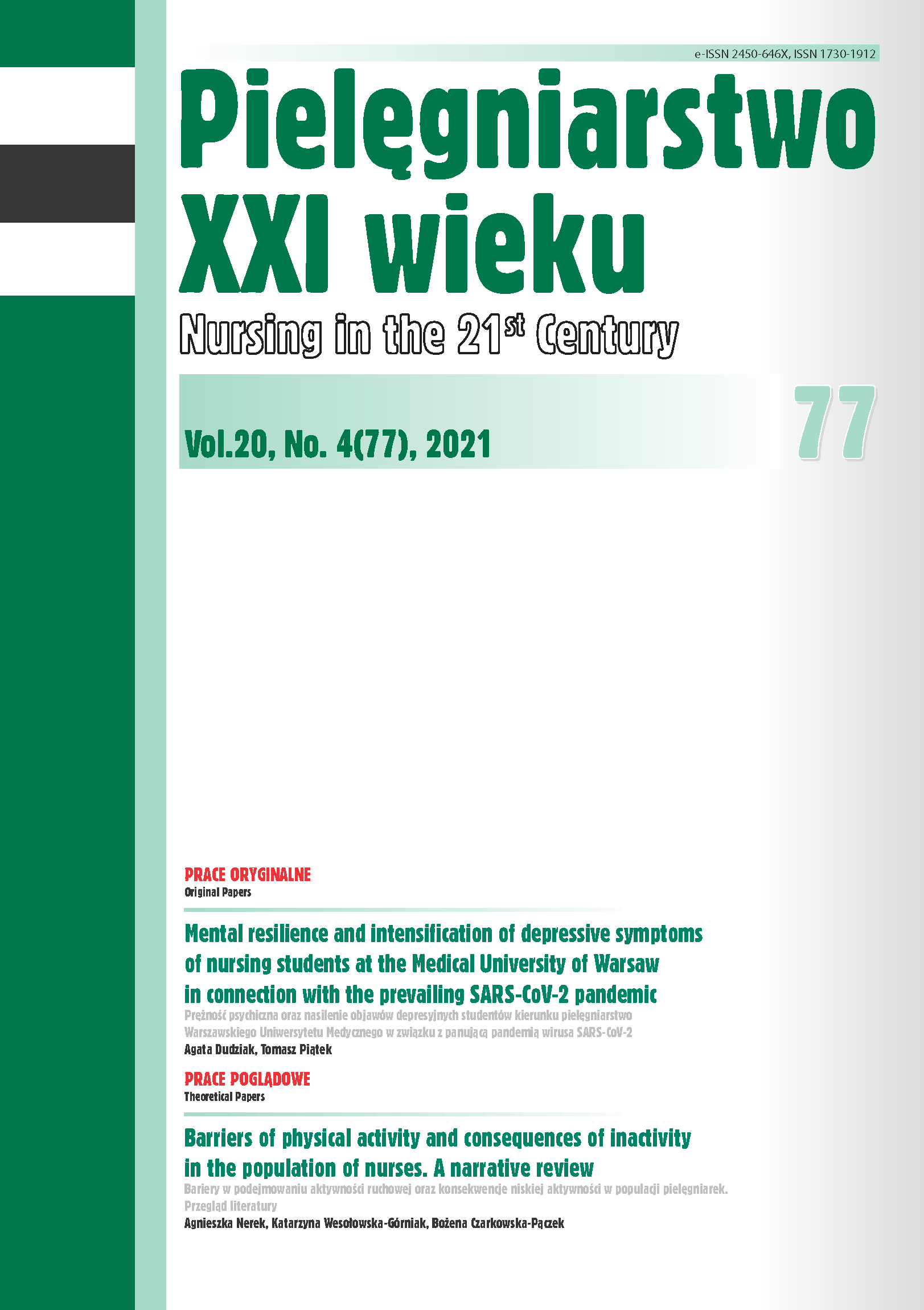The Dedicated Education Units model in the practical education of midwifery students
DOI:
https://doi.org/10.2478/pielxxiw-2021-0031Keywords:
clinical education, student, midwifery, mentor, midwife, didacticsAbstract
THE DEDICATED EDUCATION UNITS MODEL IN THE PRACTICAL EDUCATION OF MIDWIFERY STUDENTS
Aim. Identifying hindering and facilitating factors of introducing Dedicated Education Unit model in the process of midwifery students education at Medical University of Warsaw. Furthermore, to describe the experiences of project participants involved in the implementation and evaluation of Dedicated Education Units in Poland.
Material and methods. Six participants, who implemented the project of introducing DEU into practice classes at midwife course at Medical University of Warsaw, has taken part in qualitative descriptive research with focus groups. Four main questions have been chosen for the focus group. Data has been interpreted using thematic analysis.
Results. No obstacles preventing from implementing Dedicated Education Units model have been noticed. Among problems with implementing the following were mentioned: lack of awareness of the point of this model among midwives, time-consuming nature/overloaded mentors, lack of extra payment for being a mentor, underappreciation of a mentor in the working environment. Factors, which ease the implementation, were considered the following: cooperation, including concentration on common aims, good communication, proper organisation of the classes and creating a safe and supportive learning environment.
Conclusions. The Dedicated Education Units enables students to broaden and develop their practical skills in an exceptional way in safe and supporting educational environment. Using this model in practical education is one of the key elements in improving the quality of practical education for midwifery students.
References
1. Stefaniak M, Dmoch-Gajzlerska E. red. Mentoring w praktycznym kształceniu studentów położnictwa. Warszawa: Oficyna wydawnicza Warszawski Uniwersytet Medyczny; 2020.
2. Pedregosa S, Fabrellas N, Risco E, i wsp. Implementing dedicated education units in 6 European undergraduate nursing and midwifery students clinical placements. BMC Nurs. 2021. 13; 20(1): 61.
3. Edgecombe K, Wotton K, Gonda J, i wsp. Dedicated education units: A new concept for clinical teaching and learning. Contemp. Nurse. 1999; 8(4): 166-171.
4. Canadian Nurses Association (CNA): Achieving excellence in professional practice. A guide to preceptorship and mentoring. Ottawa 2004. https://saskpreceptors.ca/documents/CNA%20Preceptor%20guide.pdf (dostęp 12.01.2021).
5. American Associate of College of Nursing. https://www.aacnnursing.org/ (dostęp 02.06.2021).
6. Europejska Strategia WHO kształcenia pielęgniarek i położnych. DLVR020301- Strategia kształcenia – 14 maja 1999. Światowa Organizacja Zdrowia. Biuro Regionalne w Europie, Kopenhaga 1999. Nurses and midwives for health. A WHO European Strategy for nursing and midwifery education. Copenhagen, WHO Regional Office for Europa, 2000 (dokument /00/5010303/15).
7. Gonda J, Wotton K, Edgecombe K, i wsp. Dedicated education units: An evaluation. Contemp Nurse. 1999; 8(4): 172-176.
8. Stefaniak M, Dmoch-Gajzlerska E. Mentoring in the clinical training of midwifery students – a focus study of the experiences and opinions of midwifery students at the Medical University of Warsaw participating in a mentoring program. BMC Med Educ. 2020; 20: 394.
9. Dobrowolska B, McGonagle I, Kane R, i wsp. Ratterns of clinical mentorship in undergraduate nurse education: A comparative case analysis of eleven EU and non-EU countries. Nurse Educ. Today. 2016; 36: 44-52.
10. Moran M, Banks D. An exploration of the value of the role of the mentor and mentoring in midwifery. Nurse Educ. Today. 2016; 40: 52-56.
11. Lennox S, Skinner J, Foureur M. Mentorship preceptorship and clinical supervisio: three key processes for supporting midwives. N. Z. Coll. Midwives J. 2008; 39: 7e12.
12. Gibson T, Heartfield M. Mentoring for nurses in general practice: an Australian study. J. Interprof Care. 2005; 19(1): 50-62.
13. Górka E, Kunecka D, Szylińska A, i wsp. Coaching and mentoring in nursing practice. Pomeranian J. Life Sci. 2019; 65(1): 98-104.
14. Cummins AM, Denney-Wilson E, Homer CSE. The mentoring experiences of new graduate midwives working in midwifery continuity of care models in Australia. Nurse Educ. Pract. 2017; 24: 106-111.
15. Claeys M, Deplaecie M, Vanderplancke T, i wsp. The difference in learning culture and learning performance between a traditional clinical placement, a dedicated education unit and work-based learning. Nurse Educ. Today. 2015; 35(9): 70-77.
16. Casey DC, Clark L. Roles and responsibilities of the student nurse mentor: an update. Br. J. Nurs. 2011; 20(15): 933-937.
17. Warne T, Johansson U-B, Papastavrou E, i wsp. An exploration of the clinical learning experience of nursing students in nine European countries. Nurse Educ. Today. 2010; 30(8): 809-815.
18. Davis D, Foureur M, Clements V, i wsp. The self reported confidence of newly graduated midwives before and after their first year of practice in Sydney, Australia. Women Birth. 2012; 25(3): e1ee10.
Downloads
Published
Issue
Section
License
Copyright (c) 2021 Authors

This work is licensed under a Creative Commons Attribution-NonCommercial-NoDerivatives 4.0 International License.




